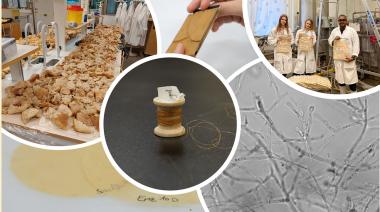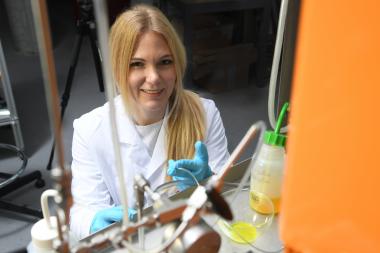Reducing environmental & health impacts of global trade of 2nd hand clothes
The rise of fast-fashion, marked by rapid turnover of collections, has led to a sevenfold increase in the global trade of used clothing in the last 4 decades. With more than 80% of all purchased clothing items globally (62% in the EU) being disposed of as general garbage, which is incinerated or landfilled, this represents a massive waste of resources, causing severe environmental and health impacts. A report recently published by UNECE and the United Nations Economic Commission for Latin America and the Caribbean (ECLAC) contains an in-depth analysis of second-hand clothing trade between Europe and Chile, offers policy recommendations to the industry, exporting and importing countries to remedy this situation.
According to UN Comtrade data, in 2021 the European Union (30%), China (16%), and the United States (15%) were the leading exporters of discarded clothes, while Asia (28%, predominantly Pakistan), Africa (19%, especially Ghana and Kenya), and Latin America (16%, mainly Chile and Guatemala) were the leading importers.
This has been facilitated by the advent of low-cost synthetic fibres and by trade liberalization that allowed the offshoring of production to countries with low-wage labour. Large proportions of clothing are made from difficult-to-separate blended fibres, making opportunities for economic reuse and recycling rare, particularly in developed countries.
“When did we normalize throwing clothes away?”, questions Lily Cole, Climate Activist and Advisor to UNECE. “As the world, mostly the Global North, has produced and consumed fashion at an unrelenting rate, a handful of countries, mainly in the Global South, have become cemeteries for the world’s unloved clothes. While visiting the Atacama Desert, my attention was brought to the textile mountains and the shifting cultural, economic, and political landscapes that birthed them. Consumer awareness is very helpful, yet, ultimately, we need policies to curb systemic trends, which is why this report and its recommendations are so necessary.”
Europe: sorting and recycling capacities lag behind
In Europe only 15-20% of disposed textiles are collected, usually through containers, door-to-door collection and donations. About half of the collected textiles are downcycled to be used as, for example, insulation, filling, and single-use industrial wipes. Only 1% is recycled into higher value outputs such as new clothing, while the remainder is exported to developing countries.
Of the 55% of collected clothes that are reusable, only 5 percentage points have a value on second-hand markets in the EU, while 50 percentage points have a value on export markets.
The European Union has thus tripled its exports of used clothes over the past 2 decades, from 550,000 to 1.7 million tons. Europe, including the United Kingdom, accounts now for more than a third of global used clothing exports, and this share could continue to grow as collection rates are expected to rise.
A design-led circular economy approach to clothing is still in its infancy. The EU Circular Economy Action Plan (CEAP) was adopted in 2020, the EU Strategy for Sustainable and Circular Textiles was adopted in 2022, and the EU Ecodesign for Sustainable Products Regulation was adopted in 2023. However, these policies are still to bear fruit in the form of large-scale upstream solutions to the problems of textile waste.
“The used clothes global market is constantly growing, and with it, its negative impacts. The textile industry has a key responsibility to adopt more sustainable practices, exporters and importers to adopt relevant policy decisions to foster traceability, circularity and sustainability. UN/CEFACT policy recommendations and standards will support this transition. And of course, we all have a role to play, as consumers, to make sustainable choices,” stressed UNECE Executive Secretary Tatiana Molcean.
The case of Chile: mountains of used clothes visible from the moon
Most countries in Latin America (including Argentina, Brazil, Colombia, Mexico, and Peru) have introduced clothing import bans to protect their national textile and fashion industries and avoid the threats posed by clothing dumps.
By contrast, Chile levies zero tariffs, and applies no quantity restrictions in imports, only requiring shipments to be sanitised (by fumigation). It has thus become one of the top 10 importers in the world, and the first in Latin America, receiving 126,000 tons of textiles in 2021. 40% of these entered the country through the northern port of Iquique, where they are manually sorted, primarily by women, and separated into first, second, and third quality.
75% of all imported used clothes were deemed non-reusable, 30,000 tons of which are covering today 30 hectares of the Atacama desert, generating pollution and creating hazard to local communities’ health. At the same time, trade in second-hand garments also provides employment and formal and informal income for national and migrant populations in established stores and open-air markets across the country, and this must be factored in when redefining public policies.
“To address the environmental and social issues of used textile trade, the EU and Chile must work together on creating robust regulatory frameworks. A partnership between the European Union and Chile could pioneer innovative approaches to regulate and reduce the impact of second-hand textile trade, including by setting global standards for the trade of used textiles, focusing on sustainability and social responsibility." Highlights UNECLAC Executive Secretary, Mr. José Manuel Salazar-Xirinachs.
Multifold recommendations
The report contains a series of recommendations to the textile industry, exporters and importers.
To exporting countries
- Make circular economy considerations central to the design of clothing, with mandatory targets for fibre composition that improve quality, durability, repairability, and recyclability
- Introduce an Extended Producer Responsibility (EPR) system holding producers responsible for the products they manufacture
- Develop more sorting and recycling plants, through financial incentives
- Develop minimum EU criteria for second-hand clothing exports through the use of digital product passports (DPPs)
- Run awareness-raising campaigns to encourage consumers to make more informed choices about their clothes
To importing countries – the example of Chile
- Improve customs procedures & administrative measures at the port of Iquique to ensure digital traceability of flows of used clothing and textile based on the UN/CEFACT traceability standard
- Establish a Circular Economy Strategy for Textiles
- Set-up public-private alliances for recycling projects through tax extension schemes and funds to support entrepreneurship, innovation, and job creation for vulnerable groups, particularly in the Tarapacá region
- Improve the legal framework for waste management
- Implement a Regional Solid Waste Control Plan, involving inspections of sanitary landfills, clean points, and dumps to increase the enforcement capacity of regional health authorities
- Accelerate the adoption of the Chilean draft law on environmental quality of soils.
The report also recommends making changes to international trade agreements, such as the2023 Interim Trade Agreement between the EU and Chile, which includes a chapter on Trade and Sustainable Development, to step up bilateral cooperation, and using it as a template for other bilateral trade agreements between the EU and other countries.
United Nations Economic Commission for Europe





